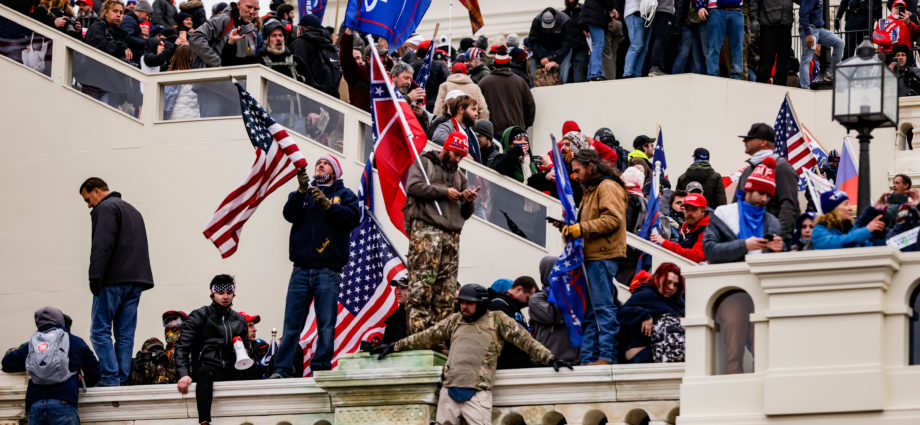Trump-inspired mob at U.S. Capitol follows a familiar path of election violence
Pro-Trump supporters storm the U.S. Capitol following a rally with President Donald Trump on January 6, 2021 in Washington, DC. Photo by Alex Gakos
Gabrielle Bardall, L’Université d’Ottawa/University of Ottawa and Robert Huish, Dalhousie University
January 8, 2021
The siege of the U.S. Capitol by Donald Trump’s supporters follows identifiable paths and patterns of election violence seen around the world.
Election violence is rarely spontaneous. It is intentionally organized in order to influence the process and outcome of elections. It is not a coup, but it is a close cousin. Coups are about change in power, often with a military backing.
Election violence begins in three clear stages, all of which have unfolded during the recent events in Washington.
First, the perpetrators convince their followers that their political grievances cannot be resolved through institutional channels of democracy. This explains why Trump has relentlessly insisted the presidential election was a fraud. Individuals may lash out spontaneously, but legitimizing violent acts is a strategy usually groomed over time until it’s whipped into a frenzy.

A traceable timing
The second stage happens when violent currents are pushed past the breaking point during expected political events, which gives election violence a traceable timing.
The attack on the Capitol was a textbook example of such timing. It happened as Congress was certifying the electoral college votes — a normally dull and largely ceremonial chore. As well, the mayhem immediately followed elections in Georgia which cost Republicans control of the Senate.
Flash points in electoral processes become triggers for election violence.
The Washington violence takes a page from Kenya in 2017, when opposition leader Railia Odinga alleged election results had been tampered with. Odinga refused to accept the loss. Deadly riots broke out around the timing of vote counting and the swearing-in of President Uhuru Kenyatta.
The 2014 coup in Thailand followed a series of protests that mirrored the counting of votes and the dissolution of parliament.
Symbolic targets
The third stage of election violence involves a symbolic target. Most peaceful protests take to the streets against a policy, event or an individual. Creative banners, powerful speakers and disruption of traffic tend to be part of the package. Rioters, not protesters, attack the symbolic landscapes of power.
Although countless protests are held in the U.S. capital every year, the events of Jan. 6 were different. It was not a protest. It was a rejection of the institution of Congress itself.
This is a disturbing break in American politics. The last attempted occupation of the Capitol was in the summer of 1932, when President Herbert Hoover refused to pay pensions to First World War veterans. Two veterans lost their lives when Hoover ordered the protesters cleared out.
The veterans sought pay from government, but they did not attempt to destroy government. Trump’s supporters were the first armed, domestic anti-democratic forces to ever occupy the building.
What’s next?
What’s even more disturbing about the electoral violence script is what may yet happen should Trump supporters shift their anger from buildings towards human beings. Looking at the history of global election violence, this threat can remain well beyond election day.
Election violence is the most extreme expression of discontent within the outer bounds of democratic processes.
When the target of the attack turns from the objects of partisan politics to the symbol of democracy itself, it is an overture to civil war. The mobs at the Capitol waved Trump flags — an attack on behalf of the executive branch of government against the legislative branch.
Justice and the rule of law
How does election violence get resolved? The best-case scenario is through human rights and the rule of law.
Perpetrators should be brought to justice and tried for their crimes (especially the instigators). Failing that, police repression and dispersion of violent mobs can put a stop to immediate destruction. (There are ongoing investigations into why the violent pro-Trump supporters were treated more favourably by police than the peaceful Black Lives Matter protesters who gathered in Washington last year.)
Finding resolution will mean dealing with Trump’s toxic hyper-masculine ego. Like Trump, sore election losers worldwide often publicly flex their muscles and stroke their bruised egos by fuelling chaos and violence in the streets.
How have other instigators of election violence been demobilized?
Often, self-centred rulers like Trump are wooed out of power by appeals to their egos. FIFA, the world soccer body, was asked by Swiss authorities in 2015 to offer a position to Burundi President Pierre Nkurunziza (a soccer aficionado) to help ease Burundi’s political crisis.
Sometimes glamorous parachutes are offered up, such as when Yahya Jammeh, the president of The Gambia, went into exile in Equatorial Guinea after an election crisis in 2016.
Backdoor, “big man” diplomacy is a bloodless way to get rid of fragile male egotists like Trump. But it comes at a terrible cost.
Root causes of violence can remain
Granting legitimacy or exile to dangerous narcissists allows for the underlying cause of the violence to remain. It is how violence replicates itself and amplifies over time. Democracy is weakened over the long term. It’s not the right solution, nor the morally desirable one.
The attack on the U.S. Capitol follows historic patterns of election violence that need to be stopped in their tracks. Any solution that shields Trump’s limitless ego and retains the legitimacy of his actions is reprehensible. Trump’s after-the-fact commitment to a “smooth” transition must not absolve him of his seditious actions.
Subscribe to our newsletter.
If the United States is, as it claims, the global cradle of democracy, then Trump must face the rule of law within that democracy and be prosecuted for sedition.
Gabrielle Bardall, Research Fellow, CIPS, L’Université d’Ottawa/University of Ottawa and Robert Huish, Associate Professor in International Development Studies, Dalhousie University
This article is republished from The Conversation under a Creative Commons license. Read the original article.

